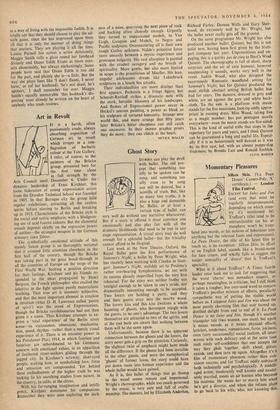Ghost Story
Last week at the New Theatre, Oxford, the Royal Ballet gave the first performance of Summer's Night, a ballet by Peter Wright, who has recently been working with Cranko in Stutt- gart. Summer's Night, stylishly set to Poulenc's rather overbearing Symphonietta, set out with its success already imperilled from the very first rehearsal. For the story was neither frothy nor vestigial enough to be taken in one's stride, nor dramatically interesting enough to be accepted. Two lovers are holding a party, and they and their guests stray into the nearby wood. The lovers kiss and this kiss awakens a whole haunting of ghosts, who thereupon mingle with the guests, to no one's advantage. The two lovers themselves are attracted to two of the spirits, and at the end both are aware that nothing between them will be the same again.
Unfortunately, because there is no apparent connection between the ghosts and the lovers, the story never gets a grip on the attention. Curiously, the slightest twist of emphasis might have made all the difference. If the ghosts had been invisible to the other guests, and were the metaphorical 'ghosts' of former loves, the story could have put down roots into human experience and the whole ballet would have gained.
As it is, this ballet of things that go thump in the wood seems remote and impersonal. Wright's choreography, while too much governed by the music, is very sure and full of crafts- manship. The dancers, led by Elizabeth Anderton, Richard Farley, Doreen Wells and Gary Sher- wood, do extremely well by Mr. Wright, but the ballet never really gets off the ground.
On the same programme Mr. Wright has also produced another ballet, Quintet, but this is not quite new, having been first given by the Stutt- gart company last year. Unpretentious and en- gaging, this is a quirky pas de cinq to Ibert's Wind Quintet. The choreography is full of short, sharp surprises and the air of cute humour, however unappealing it sounds, works very well in the event. Judith Wood, who also designed the cavernously Romantic woodland setting for Summer's Night, has for Quintet produced the most stylish abstract setting British ballet has had for years. The dancers, dressed in grey and white, are set against the grey and white back- cloth. To the side is a platform with music stands for the five musicians, looking oddly appro- priate in evening dress. Miss Wood, taking five as a magic number, has put pentagon motifs everywhere—even the music stands are five-sided. This is the kind of useful trifle that stops in the repertory for years and years, and I think Quintet can be guaranteed a long and useful life. Especi- ally if it is as boisterously well danced as it was by its first cast, led, with an almost puppy-dog friskiness, by Brenda Last and Ronald Emblen.
































 Previous page
Previous page